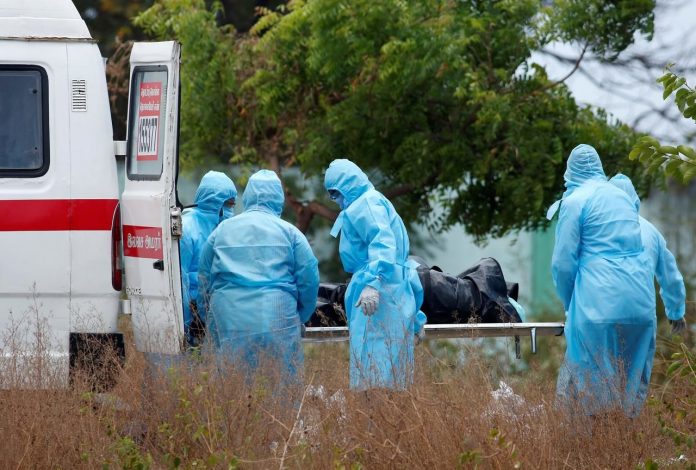This article is written by Harman Juneja, from Dr. B.R. Ambedkar National Law University, Rai, Sonepat. The article talks about the ground reality of COVID-19 and its effects on the poverty levels.
Table of Contents
Introduction
The country has been suffering from the pandemic for over a year now and after such a long time, the effect on the poverty levels of the country has been severe. Last year, the World Bank estimated in their October 2020 Global Economic Prospects report that around 88 to 115 million people would be pushed to extreme poverty but with the passage of time and the growing pandemic, this number rose to around 119 to 124 million in the January 2021 Growth Economic Prospects. The difference between poverty projected with the pandemic and poverty anticipated without the pandemic is used to determine the number of COVID-19-induced new poor. The World Bank utilizes economic prospects growth projections from January 2021 to predict poverty in the first case, and Growth Economic Prospects forecasts growth from January 2020 to predict poverty in the second case.
This Report clearly shows what a big effect COVID-19 has on the poverty levels around the world. The lesser developed nations are facing greater problems because of the lesser availability of resources. The Reports also show that the new poor will be from the countries that already have higher poverty rates. These countries are already struggling to help the poverty-stricken people and the pandemic has only added to their problems. Poverty is defined by more than just surviving on less than $1.90 a day. Poverty is more than just a lack of resources to make ends meet or pay basic expenses on time. Poverty is multifaceted and involves a lot more than just a lack of money.
Impact of COVID-19 on the sustainable development goals – a UN study
Over the last 30 years, the globe has faced numerous crises, notably the Global Financial Crisis of 2007-09. Each has had a significant impact on human progress, but overall, global development gains have increased year after year. COVID-19, with its three-pronged attack on health, education, and income, has the potential to reverse this trend. This was said by UNDP Administrator Achim Steiner in one of his speeches.
COVID-19 and Sustainable Development Goals
- The coronavirus pandemic has introduced us to a new world, one in which what used to be considered normal now seems a dream. As the virus overwhelms our bodies and economies, millions of people are enduring unspeakable pain and anguish. The epidemic has caused us to reassess nearly every facet of our lives, rich or poor. The pandemic is a huge problem as well as a huge opportunity for achieving the 2030 Agenda and the Sustainable Development Goals (SDGs). The Sustainable Development Goals (SDGs) serve as a road map for humankind. They include nearly every element of human and planetary well-being and, if met, will provide everyone with a stable and affluent existence while also ensuring the planet’s health. SDG’s have been dealt a devastating blow this year, one that will have long-term consequences.
- The pandemic, on the other hand, demonstrates the soundness of what is already written into the SDGs: the issues we confront cannot be addressed in isolation. While most developing nations are still in the early phases of the epidemic, their socio-economic evaluations, based on data from more than 70 countries and five regional studies, reveal that they are already grappling with its detrimental impacts. Even before the crisis, the globe was falling behind to provide universal healthcare by 2030.
- For the first time in a century, the entire world is focused on a single goal: to defeat the coronavirus. It’s impossible to return to “normal” because “normal” is what got us here in the first place. The crisis has taught us how intertwined we are with one another and with the environment. COVID-19 is compelling us to reconsider our principles and establish a new sector of development that properly balances economic, social, and environmental progress, as the 2030 Agenda and SDGs foresee. Integrated solutions are the only approach to assist countries to achieve the 2030 goals by building a greener and more inclusive future.
Impacts on physical and mental health
- Now, the remarkable progress made in recent years—declining infant and child mortality rates, shifting the balance on HIV/AIDS, and lowering malaria deaths—is in jeopardy, and we face potentially alarming setbacks, not only from the disease itself but also from the after-effects of the disease and vaccination campaign.
- In the last two decades, the number of undernourished persons has decreased by nearly half. Latin America, Central, and East Asia, and the Caribbean have all made significant strides forward. Despite this, 821 million people were chronically malnourished in 2017. COVID-19 has revealed flaws in the world’s food supply chains. And it has driven vulnerable countries like Yemen, where 15.9 million people wake up hungry every day despite humanitarian aid, into even deeper suffering.
- Lockdowns harm an estimated 1.25 billion students, according to UNESCO. According to the UNDP, 86 percent of primary school children in poor nations are illiterate. The pandemic has brought attention to the so-called “digital gap” and the right to internet access, particularly for those living in rural regions. According to the UNDP, eliminating the digital divide would lower the number of children who are unable to learn as a result of school closures by more than two-thirds. There have been at least 18 national elections and referendums postponed due to COVID- 19. This can sometimes lead to an increase in the danger of unrest. Governments are under unprecedented pressure to provide digital services and social protection, as well as to function in ways that promote social cohesion while safeguarding human rights and the rule of law, particularly in unstable circumstances.
Economical Impacts
Rapid economic growth in India and China has lifted millions of people out of poverty, yet around 736 million people still lived on less than $1.90 per day in 2015. According to Oxfam, the crisis could force half a billion people back into poverty. The foundation of the goals is Sustainable Development Goals. The crisis has made this aim more difficult to achieve, but it also provides an opportunity to transform development. About 1.6 billion people work in the informal economy, accounting for over half of the global workforce. According to the International Labour Organization, they are in urgent danger of losing their jobs. More than one out of every six young people has lost their job since the pandemic began, and those who are still working have had their hours slashed. UNDP will work with business and governmental partners to foster integrated growth that leaves no one behind as the lead on COVID-19’s socioeconomic response.
Poverty on the rise – is COVID-19 the reason or just another factor
For years, poverty has been increasing day by day with devastating effects on the lives of people and economies worldwide. Over the period, we have seen a lot of government systems but none of them can completely eradicate poverty from its roots. There are a lot of factors that affect poverty and the number of people in the category of below the poverty line, similarly, COVID-19 is another factor that contributed to the rise of poverty. As mentioned earlier, around 150 million people would be pushed to poverty by the year 2021 and let alone 75 million people from India fell into poverty last year.
Although the lockdown seems helpful in containing the spread of the virus it has a lot of serious side effects on people as well. Such stringent restrictions, however, will almost certainly harm the population’s mental health. Because of their fragility, certain subgroups of the population are especially vulnerable in this situation. Homeless people, migrant workers, asylum seekers, and refugees, and individuals with mental health problems are among them. Furthermore, some people will fall into multiple groupings, putting them at greater risk. Emerging evidence from the pandemic COVID-19 also shows several factors affecting child and young people’s mental health and well-being as well. Their concerns and worries about education, missing school, transitions, school leaving, academic stress, career, etc are troubling them in serious ways.
In this scenario, we estimate that containment measures will be effective in halting the virus’s spread over the coming months, with the virus’s main economic impact being a large, but short-term disruption of global economic activity. Once the movement of people, products, and services return to normal, a rebound is probable. This scenario is similar to the Organisation for Economic Co-operation and Development’s (OECD) projection of a 0.5 to 1.5 percentage point slowdown in global economic growth in 2020. Workers who are unable to perform their duties have a significant impact. As a result, labor productivity will fall by 1.4 percent on average in 2020. (This equates to a 1.4 percent reduction in labor supply)
The effects on GDP are felt through a temporary halt in domestic economic activity due to distribution channel interruptions, the inability to offer inputs and services due to worker quarantines, and so on. This is simulated by assuming a 1% loss in global GDP due to a fall in total factor productivity growth. International trade disruptions have caused a nearly 5% increase in the cost of conducting business, enough to cause a 1% cost of world economic growth.
The most egregious lockdown blunder was barring migrant employees from returning home when illness levels were low and any further spread could have been readily contained. First and foremost, the migration crisis tells us that the epidemiological and humanitarian effects of any big move should always be properly studied in advance.
What do the bureaucratic reports and studies miss out on
The COVID-19 pandemic has resulted in a significant loss of human life around the world, and it poses an unprecedented threat to public health, food systems, and the workplace. The pandemic’s economic and social effects are devastating: tens of millions of people are at risk of falling into extreme poverty, and the number of undernourished people, which is presently estimated to be around 690 million, might rise to 132 million by the end of the year. The governments around the world are so busy with improving their medical system and the reports and analysis are much centered around the patients suffering from COVID-19 or those who have died from it. These reports easily tend to miss out on the harsh realities and ground-level problems that are caused due to the virus. Let’s look at some of the aspects which are not being focused upon:
- While feeding the globe, millions of agricultural workers – both paid and self-employed – confront high levels of working poverty, malnutrition, and bad health, as well as a lack of safety and labor protection, as well as various forms of abuse. Because of their poor and irregular salaries, as well as a lack of social support, many of them are compelled to continue working, often in hazardous situations, putting themselves and their families at risk.
- Furthermore, when faced with a lack of income, individuals may turn to negative coping techniques such as asset distress sales, predatory lending, or child labor. Migrant agricultural laborers are particularly vulnerable because they confront dangers in their transportation, working, and living situations, as well as a lack of access to government-sponsored assistance.
- Food security, public health, and employment and labor issues, particularly worker health and safety, all intersect during the COVID-19 crisis. The human dimension of the problem will need adherence to workplace safety and health measures, as well as providing access to decent work and the protection of labor rights in all industries. Immediate and focused action to save lives and livelihoods should include expanding social protection to encompass universal health coverage and financial support for the most vulnerable.
- COVID-19 has a particularly negative impact on countries that are currently dealing with humanitarian crises or emergencies. It’s vital to respond quickly to the pandemic while also ensuring that humanitarian and rehabilitation aid reaches those who need it most.
These are some of the areas that are not being focused on because immediate medical needs are being considered while making policies. Along with these some diplomatic and political reasons also come in the way of making policies for such distressed people.
Indians and poverty during the COVID era
During the initial wave of the COVID-19 pandemic, a statewide lockdown to stop the spread of the virus robbed millions of Indians of their employment and livelihood. According to research undertaken by the Pew Research Center, a think tank located in the United States, the first wave of the coronavirus pandemic in India may have doubled poverty. According to the Report, income levels in India fell substantially for a huge portion of the population after the nationwide shutdown, based on World Bank forecasts of economic development. Last year, the pandemic wreaked havoc on practically every industry, leading to enormous employment losses in both the formal and informal sectors of the economy. Various problems have been identified by this and other reports as well which are discussed below:
- Due to the pandemic, India’s GDP (gross domestic product) growth rate was one of the lowest among rising economies. Last year, India’s poor faced the brunt of the country’s economic downturn. Pew Research classified India’s income levels as follows: $2 or less per day (poor), $2.01 to $10 per day (low income), $10.01 to $20 per day (middle income), $20.01 to $50 per day (upper middle income), and $50 or more per day (high income) (high income).
- According to the Report, the number of impoverished individuals in the country climbed from 6 crores to 13.4 crores, with daily incomes of less than $2 (Rs 150). As a result, India’s poor population expanded by nearly 7.5 crores last year. As the economy entered a downturn in 2020, India’s enormous middle class decreased by 3.2 crores, falling to 6.6 crores from 9.9 crores before the pandemic.
- According to the Report, the number of impoverished individuals in the country climbed from 6 crores to 13.4 crores, with daily incomes of less than $2 (Rs 150). As a result, India’s poor population expanded by nearly 7.5 crores last year. As the economy entered a downturn in 2020, India’s enormous middle class decreased by 3.2 crores, falling to 6.6 crores from 9.9 crores before the pandemic.
- According to new research by Nomura, the impact of the second wave on the economy would be worse than projected. Tighter regulations, according to the report’s authors, are wreaking havoc on businesses, particularly smaller ones. While experts had predicted that the second wave would only have a short-term impact on economic growth, the situation quickly shifted, with several states opting for a near-complete lockdown to prevent a rapid increase in COVID-19 cases.
In crucial urban areas such as Maharashtra and Delhi-NCR, economic activity has come to a halt. As the second wave continues unabated, many additional states have enforced localized lockdowns. The limits on travel have exacerbated losses for small firms, which are still reeling from the pandemic’s initial effects. Several industries, including aviation, tourism, retail, entertainment, and restaurants, are once again concerned about a repeat of the year 2020.
Can India overcome the economic slip faced because of the pandemic
As India works to strengthen its economy, it’s important considering the additional fundamental changes that will be required to move the country toward a more sustainable and resilient economy. Here are a few suggestions that are all related:
- Through suitable legislation and commercial models, India should seize the potential to enhance support for renewable energy, particularly rooftop solar.
- If the initial capital limits can be overcome, decentralized solar power can help distribute important services to rural areas. It should reconsider the possibility of imposing import tariffs on solar panels, as this would not promote domestic production but would raise the cost of solar energy.
- Approximately 90% of India’s workforce is informally employed, including gig economy employees. This population is very exposed to economic shocks and requires more formal credit as well as social safety nets like insurance and pension plans. A universal basic income, which is broader than present plans that are conditional on occupation and property ownership, can assist in providing necessary resources for subsistence as well as investment in education and health care. Greater access to bank accounts for the 20% of persons who do not have one, according to 2017 data, will assist transfer this money to households more efficiently.
- While fostering low-carbon development, fiscal measures can aid recovery and resilience initiatives. Among other things, the Indian government has announced an INR 1.7 trillion ($24 billion) economic boost and is considering another INR 750 billion rescue for Micro, Small, and Medium Enterprises (MSME). Though MSMEs require immediate funding to meet their payroll obligations, the government can also provide money to help them increase their industrial energy efficiency.
- Consumption patterns have shifted as a result of the current crisis. People are working from home on more flexible schedules, which has changed how they use electricity. Purchases of non-essential items have been temporarily halted. All of these factors present an opportunity to apply demand-side solutions that will result in long-term behavioral changes that will lead to more sustainable growth. Encouragement of energy conservation, for example, through nudges and tariff adjustments, can reduce usage. Promoting consumption models of reuse, recycling, and repair can help to create a circular economy and reduce waste caused by present business models. Supporting work-from-home policies can help reduce traffic congestion and pollution on the roads.
- Finally, keep in mind that the gig economy and e-commerce sectors, as well as emerging technologies that can support future response and resilience measures, may see increased employment in the future. While encouraging the growth of such industries, it is critical to ensure that data privacy and consumer protection are protected.
Along with all these measures India can also work with UNDP in a much effective way and make policies to fight increasing poverty. UNDP works in 170 countries and territories to eradicate poverty and decrease inequality as the UN’s primary agency for international development. They assist nations in developing policies, leadership skills, partnership ability, institutional capacity, and resilience to meet the Sustainable Development Goals. Sustainable development, democratic governance and peacebuilding, and climate and disaster resilience are the three focal areas of our work. India is already working with UNDP on various policies such as the project named GOALS (Governance and Accelerated Livelihoods Support), DISHA, etc. These policies are made with a lot of deliberations and while keeping in mind a lot of aspects so efforts should be made to strengthen these policies so that these policies can give the results anticipated.
Conclusion
COVID-19 has done a lot of harm to the already struggling world and increasing poverty is also one of them. The world has already been struggling with increasing poverty and the lockdown and shutdown of the economy have added to it. This however is not the end as it has provided us with a lot of opportunities to change the way economies and goals used to work. . Instead of looking at narrower things, the focus should be shifted on broader aspects and work should be taken up accordingly. UNDP has been working hard for helping countries with attaining sustainable development goals and every country should work with them to make a balanced and effective strategy. A lot can be done in the future to increase the poverty levels and make a better system for everyone
References
- https://en.unesco.org/news/secretary-general-warns-education-catastrophe-pointing-unehttps://www.ilo.org/global/about-the-ilo/newsroom/news/WCMS_745879/lang–en/index.htm
- https://datacatalog.worldbank.org/dataset/global-financial-inclusion-global-findex-database
- https://www.indiabudget.gov.in/economicsurvey/doc/vol2chapter/echap10_vol2.pdf
LawSikho has created a telegram group for exchanging legal knowledge, referrals, and various opportunities. You can click on this link and join:
 Serato DJ Crack 2025Serato DJ PRO Crack
Serato DJ Crack 2025Serato DJ PRO Crack











 Allow notifications
Allow notifications



